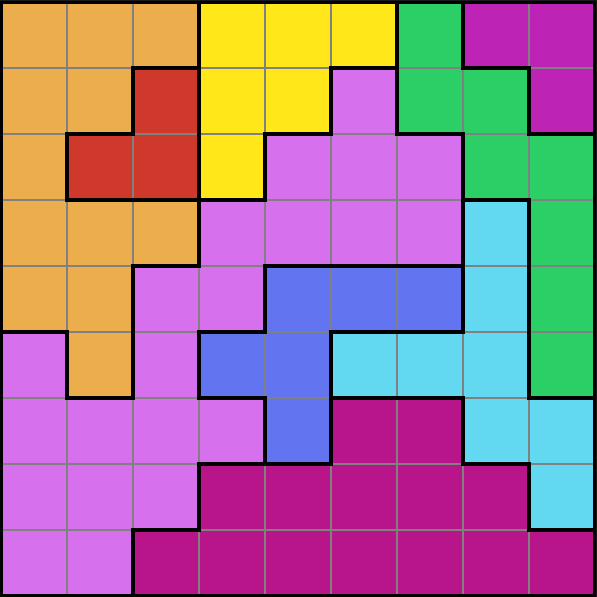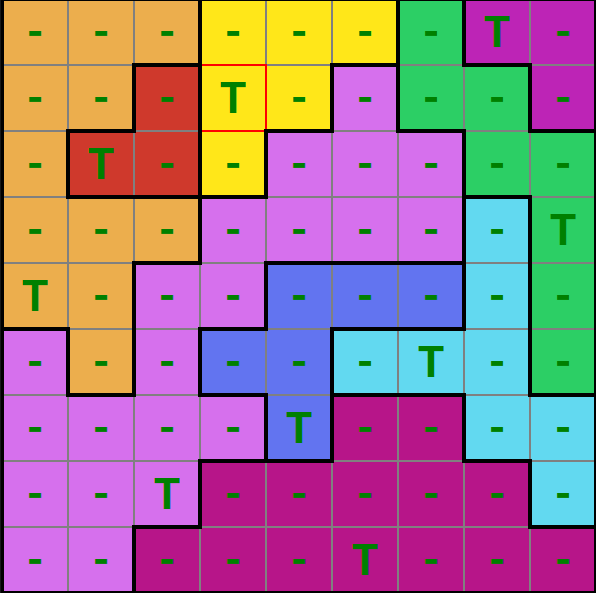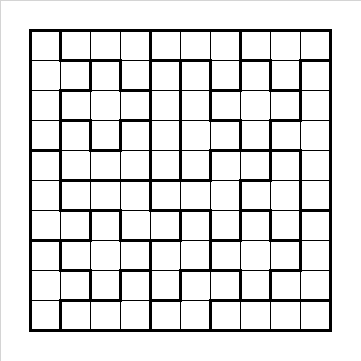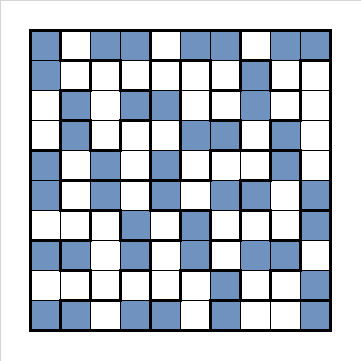NON-MINESWEEPER PUZZLE GAMES (02/10/24 MM/DD/YY)
- TREE PUZZLES (VIA SPORCLE)
Each row, column, and colored shape each contains exactly one tree. Trees can not touch, even diagonally.Mark each tree with a "T", and everywhere where there cannot be a tree with a "-". (You must completely fill in the grid to complete the puzzle).This puzzle can be solved without guessing, and only has one possible solution.- NORINORI (VIA
puzzle-norinori.comorpuzsq.jp) - YAJILIN (VIA
puzsq.jp) - MASYU (VIA
puzsq.jp) - KILLER EXPERT SUDOKU (VIA
sudoku.com) - SLANT (VIA
puzzle-slant.comorpuzsq.jp) - NURIKABE (VIA SPORCLE or
puzsq.jp) - SLITHERLINK (VIA
puzsq.jp)
THE BEST
These are my favorites to do day-to-day. Pioneered by Katie_Wandering on Sporcle, tree puzzles are really pleasant to play. Pretty simple rules, which read as the following (from Katie_Wandering):
As an example, here is Katie_Wandering's "Trees Logic Puzzle 484," unsolved and then solved.


When those base tree puzzles become trivial, there are the increasingly harder variations, like the double tree and triple tree puzzles from Katie_Wandering (where each region has two or three trees respectively), or various other variants descendent from Katie_Wandering's work elsewhere on Sporcle.
I should probably make a tutorial of my strategies for these, as I don't think there's any comprehensive written guide to the tips and tricks of them out there (at least as far as I know, email me if there is). If you want something to start off with, there's a simple Sporcle walkthrough of the first tree puzzle, which can be found here.
Norinori puzzles are part of a series of a bunch of different Japanese puzzles I've been getting into recently. Most of them are actually made by one puzzle design company, Nikoli. These puzzles are pretty simple, and pretty fun. Basically (a little similar to tree puzzles), there are various divided regions of tiles. Each of these regions has to have 2 colored tiles. All colored tiles must be in groups of two (called dominoes), and cannot touch directly (diagonal is fine).
Here's an example Norinori puzzle, unsolved and then solved, shamelessly stolen from the Logic Puzzle Wiki.


Again, I should probably make a tutorial of my strategies for these, as I don't think there's any comprehensive written guide to the tips and tricks of them out there (once again, email me if there is).
These are a new addition to my arsenal, created by Nikoli once again. It's the first of the loop-based puzzles I'd played (as opposed to tile-coloring like Norinori and others), and it's been pretty fun. It's one of the most popular in Japanese puzzle circles, as far as I can tell. Basically, with loop puzzles, you have to make one continuous loop around the puzzle, and then you get clues based on whatever the puzzle's gimmick is. With Yajilin, there are little arrow blocks with the number of how many shaded (meaning non-loop) blocks are in that direction (see the PDF I link below for an example). Like Norinori, these blocks cannot touch.
Finally, there's some outside sources for this one. If you'd like to learn some tricks, here's a great guide PDF from the UK Puzzle Association on Yajilin.
Masyu is also new to my list of puzzles to do, and it was also created by Nikoli, and is also a loop-based puzzle. It involves white and black circles (called pearls), where the loop has to turn on black pearls, and go straight for one tile after passing through it. For the white pearls, the loop must go straight through it, and has to turn on at least one side of the circle. Very fun puzzles, and once again they seem to be very popular in the (quite large) Japanese puzzle community.
Again, there's some outside sources for this one. If you'd like to learn some tricks, here's another great guide PDF from the UK Puzzle Association, but on Masyu this time.
Base Sudoku really doesn't need any introduction. If you're not familiar with it, I'm surprised you've gotten to this webpage and read this far down the list. Killer Sudoku, though, is less well known. Basically, it adds little dashed regions (called cages) on top of the normal Sudoku board. These cages have a number associated with them, and that is what the numbers inside the cage have to add up to. That's basically the whole idea. I like to play sudoku.com's Killer Expert because it starts with no numbers given, and comes with a nice timer. At some point they added lives, for some reason, and try to get you to restart if you make 3 mistakes. I find that pretty stupid since it's almost always because I accidentally put a number down instead of using the note function. The site's pretty bloated in general, so if you have a better one with Killer Sudoku puzzles and a timer please let me know.
Since Sudoku is obviously very popular, there's obviously a lot of sources on it. Here's a great Killer Sudoku guide from killersudokuonline.com.
THESE ARE ALRIGHT
Slant (originally called Gokigen Naname by Nikoli, but it seems like that name has fallen out of use even on Japanese sites) is a line puzzle, but not a loop puzzle (in fact, it's sort of an anti-loop puzzle). Basically, there are little nodes with a number associated with it, and that's how many lines intersect into that node. Lines can only go diagonally. Other than that, the only other rule is that you cannot create a loop of any shape. These are alright, but I don't really enjoy playing the difficult ones.
There aren't too many good written guides for these, but surprisingly the Wikipedia page for Gokigen Naname has a great tutorial.
Nurikabe is yet another Nikoli-made puzzle which has also had some success outside Japan other various other names (I originally saw them on Sporcle). I'm not too good at them, but they're good and definitely worth mentioning.
Again, the Nurikabe Wikipedia page comes to the rescue. Not nearly as good a guide as the Slant one, but it's still a good place to start.
Slitherlink (also called Fences) is a pretty simple loop grid-based puzzle, where numbers in between some of the dots that make up the grid tell you how many sides of that square are part of the loop. Pretty fun, but nothing too exciting in my opinion.
Back again, here's another great guide PDF from the UK Puzzle Association for Slitherlink puzzles.
Since they've proven themselves to be a good source, here's the library of puzzle resources from the UK Puzzle Association.
As always, you can email me (at laymanpang (at) mailfence (dot) com) with any suggestions for puzzles I might like, or for better written sources for some of these with a smaller audience. Also please let me know if any of the many links in this article don't open in another tab, or if there are typos on the site.